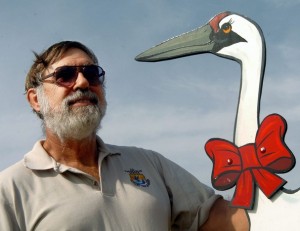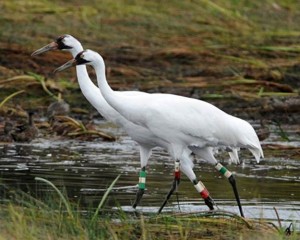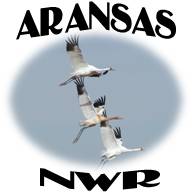Whooping Cranes Quicken Flight to Aransas Winter Home
By Chester McConnell, Whooping Crane Conservation Association
Whooping crane numbers are increasing rapidly on Aransas National Wildlife Refuge each day. While no official census will be made until later this month, refuge official report seeing growing numbers of the endangered birds. Dan Alonso, Refuge Manager told the Whooping Crane Conservation Association that “26 whooping cranes had been observed on the refuge along Shore Road”. More whoopers are likely on the refuge in areas where they are more difficult to spot.
Manager Alonso also advised that, “8 of the 20 radio marked whooping cranes have arrived on the refuge according to the U.S. Geological Survey monitoring team.” Radio equipment was placed on 20 whoopers to track their migration path from their nesting grounds on Wood Buffalo National Park, Canada to their winter habitat on Aransas Refuge, Texas. Biologists in Canada and the United States have studied whooping cranes for many years but still do not know all the bird’s secrets. Due to increasing developments along the cranes migration route, biologists and development interests need to know more about whooping crane movements to help protect the birds.
“Aransas Refuge is still in the midst of a severe drought” according to Refuge Manager Alonso. “The refuge and entire state of Texas is in serious need of rain”, he said. Weather reports are predicting rain for parts of Texas within the next few days and hopefully Aransas will get a good soaking.
Alonso explained that, “a second growing problem is the red tide in waters off shore of the refuge.” He stated that while, “red tide is always an issue, the current red tide is one of the worst ever recorded. The situation is monitored regularly by Texas Parks and Wildlife Department biologists.” He warned that “whooping cranes can die or become sickened by eating red tide infected mollusk.” He does not know if red tide has ever killed a whooping crane because dead cranes are often eaten by predators.
The last seriously bad red tide, similar to the current situation, was during 1995, according to manager Alonso.
We asked manager Alonso about the effect of crab trapping in the vicinity of Aransas Refuge. He explained that the U.S. Fish and Wildlife Service had searched for traps near Aransas refuge and had located none within 300 feet of the refuge shore. He reiterated that the reason for apparent absence of traps is that the waters near the refuge are too shallow for crabbing.
Whooping Crane Conservation Association Urges Crabbing Closure
Whooping Crane Conservation Association president Lorne Scott sent letter to Texas Parks and Wildlife Department Executive Director Carter Smith requesting measures to help ensure adequate food source for whooping cranes. President Scott advises,”The Whooping Crane Conservation Association (WCCA) has been working to help whooping cranes for over 60 years. Since blue crabs are the main food source for wintering whooping cranes at Aransas, we are concerned with the long-term decline of blue crabs Gulf-wide, including the Texas coast. Specifically, we urge your Department to institute a seasonal closure on blue crab harvest in areas used by wintering whooping cranes.”
In 2009, personnel of Texas Parks and Wildlife Department (TPWD -Fisheries and Regulatory divisions) and Aransas National Wildlife Refuge (NWR) met several times and developed a proposal to expand the crab closure zone to all marshes currently being used by wintering whooping cranes. Also proposed was a closure 300 feet out from the marshes in the shallow parts of the bays where whooping cranes may forage. With crabbing currently prohibited on Aransas and Matagorda Island NWRs, the proposal would affect marshes on San Jose Island, Welder Flats and Lamar as well as bay edges throughout the crane area. This proposal would increase availability of blue crabs for wintering whooping cranes, reduce disturbance to the cranes, and would reduce the problem of traps being abandoned in the shallow marshes. The proposed closure would be seasonal in nature only for when the cranes are on the Texas Coast from October 15th through April 15th.
Your Department wanted to collect additional information on exactly how many licensed crab fisherman would be impacted, but this was never completed. TPWD personnel subsequently decided not to present this matter to your Commission, and the proposal was dropped.
The WCCA requests that TPWD re-consider this matter and bring it before the Commission. The closure would impact only a handful of commercial crabbers; it would reduce the problem of crab traps being placed in the shallow marshes and later abandoned when tides become too low to check traps; and it would signal the Department’s concern about the blue crab resource and the endangered whooping crane. In 2009, the Aransas NWR began to enforce a closure of the crab fishery on Matagorda Island. A similar move by TPWD for the crane areas including San Jose Island, Welder Flats and Lamar would benefit whooping cranes by increasing their food supply. It makes little sense to be trapping crabs during the whooping crane season (October 15 to April 15) since low tides during the winter make most of the marshes and bay shorelines inaccessible with fisherman unable to access traps. A seasonal closure would also reduce disturbance to whooping cranes, an issue of increasing concern as more and more people are able to access even the shallowest of marshes with kayaks and airboats.
A map of the seasonal proposed closure as discussed in 2009 is attached. We urge your Department to bring this matter to your commission for passage.
Two whooping cranes found dead in Jefferson Davis Parish
Louisiana Department of Wildlife and Fisheries (LDWF) Enforcement Division agents have identified two juveniles for their alleged role in the illegal shooting of two whooping cranes in Jefferson Davis Parish.
Hunters: Know Your Cranes
From Plaindealer-sun.com
9/19/2011 2:13:00 PM
What’s a whooping crane worth?
by Neil Case
Two men in Indiana shot and killed a whooping crane and were caught. The whooping crane is an endangered species. As such, it is protected under the Endangered Species Act, a federal law. These men were taken to federal court, found guilty and fined. One dollar each! They were also ordered to pay legal fees and court costs of $550.
A man in Texas shot and killed a whooping crane and was caught and taken to federal court. He was fined $120,000 and sent to jail for six months. Seven men in Kansas, a hunting party, shot and killed two whooping cranes. They were fined a total of $23,586 and given two years probation each.
So is a whooping crane worth one dollar or is it worth $10,000 or more? Someone who kills a bird or other animal officially listed under the Endangered Species Act may be fined up to $100,000 and sentenced to a year in jail. But the whooping crane killed in Indiana was a bird of a “nonessential experimental population.”
These birds are raised at the Patuxent Wildlife Research Center and the International Crane Foundation. Subsequently they’re taken to Necedah National Wildlife Refuge in Wisconsin, taught to follow ultralite aircraft as they learn to fly and led by ultralites to Florida in the fall. It’s an attempt to establish an eastern population of whooping cranes. Raised in captivity, led by ultralite aircraft to a winter grounds in Florida, these birds return on their own to Wisconsin in spring and eventually, it is hoped, they will mate, nest and raise young, then adults and young will migrate to Florida for the winter.
Whooping cranes and other endangered species are protected by law because they are rare.
In addition to being few in number, whooping cranes are striking birds, over four feet tall with a long neck and legs, white with red on the forehead and up onto the top of the head. Once they nested from northern Canada into the northern plains states and in some of the Gulf Coast states. The northern birds migrated south in the fall and all of them wintered along the Gulf Coast.
Today, naturally occurring wild whoopers nest in Wood Buffalo National Park, northwest Canada and winter along the coast of Texas in the Aransas National Wildlife Refuge. Every winter, thousands of people visit the Aransas National Wildlife Refuge hoping to see a whopping crane.
Capitalizing on the number of people who visit Texas to see whooping cranes in winter, the nearby town of Port Aransas has a Whooping Crane Festival every winter. People who attend can hear lectures about whooping cranes, see videos and take a boat ride into the waters of the Aransas National Wildlife Refuge where they are almost certain to see whooping cranes and usually one or more of their families, including a pair of adults and an immature bird.
A federal judge in Indiana assigned a value of one dollar to a whooping crane. A federal judge in Texas assigned a value of $10,000 and a judge in Kansas assigned an even higher value. Motel owners, restaurant owners, and souvenir shop owners in Port Aransas, Texas undoubtedly agree with the higher assessments since their businesses flourish in winter when visitors come to the area to see whooping cranes. There are other people, I’m sure, who wouldn’t care if the whooping crane became extinct.
So what is a whooping crane worth? Carrying the question further, what are the swallows and warblers feeding on insects worth, the sparrows and finches eating and scattering seeds, vultures providing roadside sanitation, hummingbirds pollinating flowers, hawks preying on mice and other small animals, robins eating wild cherries and passing the seeds, blue jays burying acorns? Aside form such practical considerations, what’s it worth just to be able to see a whooping crane or any other bird?
The Whooping Crane Conservations Association whoopingcrane.com attempts to assist in the education of hunters to help prevent the killing of endangered species such as the whooping crane. We are attaching an “identification” aide prepared by the Louisiana Wildlife and Fisheries department to further assist hunters in identification. The Louisiana article includes photos of large birds similar to whooping cranes. Some are illegal to hunt while others are legal. Hunters need to know the difference. If you are a hunter and are not certain of the identification of the bird you are aiming at, please don’t shoot. Better safe than sorry. Click on the following link:
For even more identification help, go to the Whooping Crane Conservation Association web site at https://whoopingcrane.com/whooper-identification/
Whooping Crane numbers
Posted by: Jim Williams under Bird conservation Updated: September 29, 2011 – 5:26 PM
Update on Whooping Crane population as distributed by Robert Russell, bird biologist with the U.S. Fish and Wildlife Service in St. Paul.
*****
The Aransas-Wood Buffalo National Park (Canada) population (AWBP) of Whooping Cranes rebounded from 263 in the spring of 2010 to 279 in the spring, 2011. With approximately 37 chicks fledged from a record 75 nests in August 2011, the flock size should reach record levels of around 300 this fall. Threats to the flock in Texas including land development, reduced freshwater inflows, the spread of black mangrove, the long-term decline of blue crab populations, sea level rise, land subsidence, and wind farm and power line construction in the migration corridor all continue to be important issues.
Twelve Whooping Crane juveniles were captured in Wood Buffalo National Park in August 2011 for attachment of radio-tracking devices, bringing the total number of radioed birds to 23. The radio signals are used to track movement of the birds.
Ten captive-raised Whooping Cranes were released in February, 2011 at White Lake, Louisiana where a wild non-migratory flock had resided up until 1950. Seven of the birds were alive after the first seven months of the project.
Production in the wild from reintroduced flocks in 2011 was again very disappointing with no chicks fledged in Florida or Wisconsin. Incubation behavior in Florida and nest abandonment in Wisconsin continued to be the focus of research. Data collected so far in Wisconsin indicates that swarms of black flies play some kind of role in a majority of nest abandonments.
The captive flocks had a good production season in 2011. Approximately 17 chicks were raised in captivity for the non-migratory flock in Louisiana, and 18 chicks are headed for Wisconsin (10 for the ultralight project at the White River marshes, and 8 for Direct Autumn Release at Horicon National Wildlife Refuge). Approximately four chicks of high genetic value were held back for the captive flocks.
Including juvenile cranes expected to be reintroduced this fall, flock sizes are estimated at 278 for the breeding flock in Canada, 115 for the Wisconsin to Florida flock, 20 nonmigratory birds in Florida, and 24 in Louisiana. With 162 cranes in captivity, the total world population of Whooping Cranes is 599.
Below is a pair of Whooping Cranes photographed last summer at Necedah National Wildlife Refuge in Wisconsin.
Tom Stehn Retires

Tom and Lipstick
Tom Stehn, Whooping Crane Coordinator, U.S. Fish and Wildlife Service will be retiring on September 30, 2011. Tom has been an outstanding Coordinator for the Whooping Crane program. He has always worked with all interests including the Whooping Crane Conservation Association. Always at the ready to answer emails and telephone calls and serve as a speaker at our programs, Tom has served us and all others exceptionally well. Tom is from the old school and knows and appreciates the role of private conservation groups. We could ask for no better. The U.S. Fish and Wildlife Service could ask for no better. We will miss Tom but wish him the best in retirement.
I asked Tom to give us a final message…
“My news from Aransas is that I am going to retire September 30th! I feel so lucky to have been able to have such a rewarding career and work with such wonderful people. After 29 years at Aransas doing crane work and 32+ years federal service, it’s time for a change, whatever the future may bring. We’ll stay in Aransas Pass on the Texas coast since my wife will continue her solo practise as a family physician. I’ll be windsurfing daily and planning trips to the mountains to do more hiking. It is likely that an acting whooping crane coordinator will be appointed to carry on the program. Refuge Biologist Brad Strobel will lead the whooping crane monitoring program at Aransas.”
Tom Stehn.



